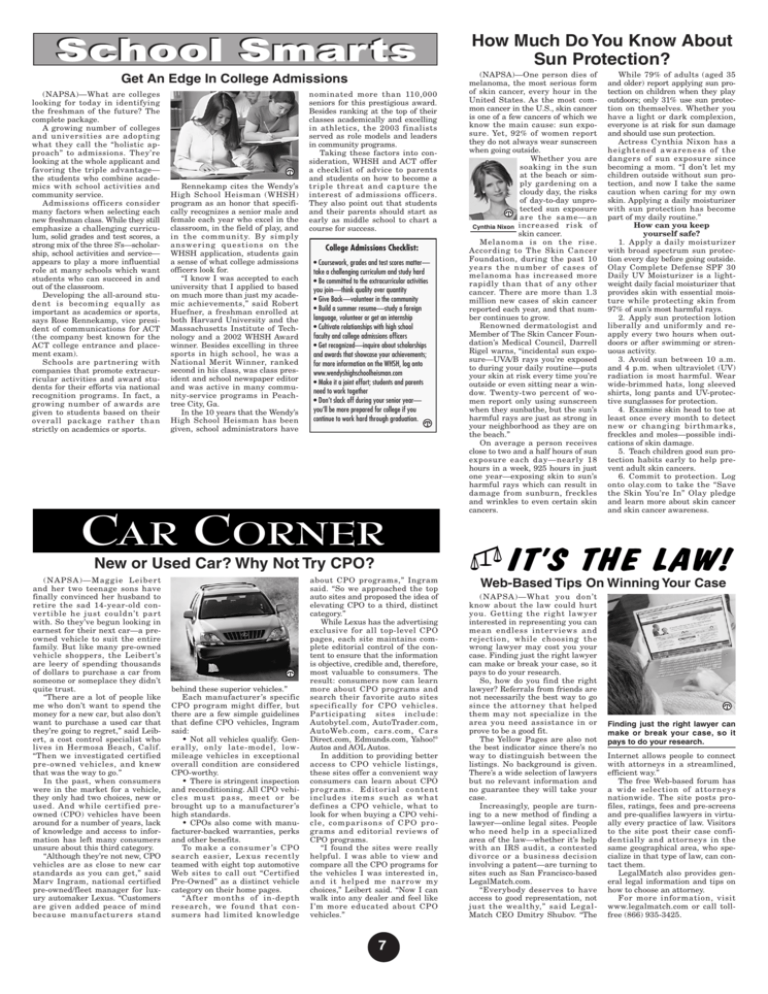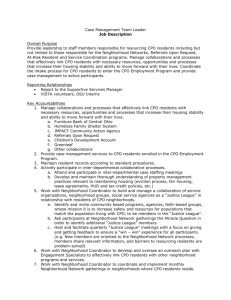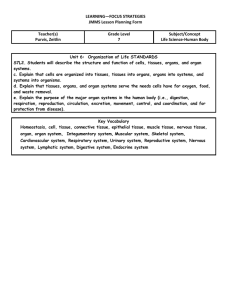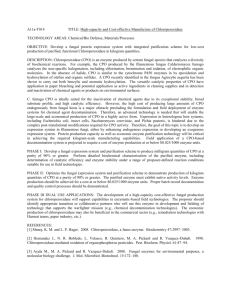Web-Based Tips On Winning Your Case
advertisement

How Much Do You Know About Sun Protection? Get An Edge In College Admissions (NAPSA)—What are colleges looking for today in identifying the freshman of the future? The complete package. A growing number of colleges and universities are adopting what they call the “holistic approach” to admissions. They’re looking at the whole applicant and favoring the triple advantage— the students who combine academics with school activities and community service. Admissions officers consider many factors when selecting each new freshman class. While they still emphasize a challenging curriculum, solid grades and test scores, a strong mix of the three S’s—scholarship, school activities and service— appears to play a more influential role at many schools which want students who can succeed in and out of the classroom. Developing the all-around student is becoming equally as important as academics or sports, says Rose Rennekamp, vice president of communications for ACT (the company best known for the ACT college entrance and placement exam). Schools are partnering with companies that promote extracurricular activities and award students for their efforts via national recognition programs. In fact, a growing number of awards are given to students based on their overall package rather than strictly on academics or sports. Rennekamp cites the Wendy’s High School Heisman (WHSH) program as an honor that specifically recognizes a senior male and female each year who excel in the classroom, in the field of play, and in the community. By simply answering questions on the WHSH application, students gain a sense of what college admissions officers look for. “I know I was accepted to each university that I applied to based on much more than just my academic achievements,” said Robert Huefner, a freshman enrolled at both Harvard University and the Massachusetts Institute of Technology and a 2002 WHSH Award winner. Besides excelling in three sports in high school, he was a National Merit Winner, ranked second in his class, was class president and school newspaper editor and was active in many community-service programs in Peachtree City, Ga. In the 10 years that the Wendy’s High School Heisman has been given, school administrators have nominated more than 110,000 seniors for this prestigious award. Besides ranking at the top of their classes academically and excelling in athletics, the 2003 finalists served as role models and leaders in community programs. Taking these factors into consideration, WHSH and ACT offer a checklist of advice to parents and students on how to become a triple threat and capture the interest of admissions officers. They also point out that students and their parents should start as early as middle school to chart a course for success. College Admissions Checklist: • Coursework, grades and test scores matter— take a challenging curriculum and study hard • Be committed to the extracurricular activities you join—think quality over quantity • Give Back—volunteer in the community • Build a summer resume—study a foreign language, volunteer or get an internship • Cultivate relationships with high school faculty and college admissions officers • Get recognized—inquire about scholarships and awards that showcase your achievements; for more information on the WHSH, log onto www.wendyshighschoolheisman.com • Make it a joint effort; students and parents need to work together • Don’t slack off during your senior year— you’ll be more prepared for college if you continue to work hard through graduation. (NAPSA)—One person dies of melanoma, the most serious form of skin cancer, every hour in the United States. As the most common cancer in the U.S., skin cancer is one of a few cancers of which we know the main cause: sun exposure. Yet, 92% of women report they do not always wear sunscreen when going outside. Whether you are soaking in the sun at the beach or simply gardening on a cloudy day, the risks of day-to-day unprotected sun exposure are the same—an Cynthia Nixon increased risk of skin cancer. Melanoma is on the rise. According to The Skin Cancer Foundation, during the past 10 years the number of cases of melanoma has increased more rapidly than that of any other cancer. There are more than 1.3 million new cases of skin cancer reported each year, and that number continues to grow. Renowned dermatologist and Member of The Skin Cancer Foundation’s Medical Council, Darrell Rigel warns, “incidental sun exposure—UVA/B rays you’re exposed to during your daily routine—puts your skin at risk every time you’re outside or even sitting near a window. Twenty-two percent of women report only using sunscreen when they sunbathe, but the sun’s harmful rays are just as strong in your neighborhood as they are on the beach.” On average a person receives close to two and a half hours of sun exposure each day—nearly 18 hours in a week, 925 hours in just one year—exposing skin to sun’s harmful rays which can result in damage from sunburn, freckles and wrinkles to even certain skin cancers. While 79% of adults (aged 35 and older) report applying sun protection on children when they play outdoors; only 31% use sun protection on themselves. Whether you have a light or dark complexion, everyone is at risk for sun damage and should use sun protection. Actress Cynthia Nixon has a heightened aw areness of the dangers of sun exposure since becoming a mom. “I don’t let my children outside without sun protection, and now I take the same caution when caring for my own skin. Applying a daily moisturizer with sun protection has become part of my daily routine.” How can you keep yourself safe? 1. Apply a daily moisturizer with broad spectrum sun protection every day before going outside. Olay Complete Defense SPF 30 Daily UV Moisturizer is a lightweight daily facial moisturizer that provides skin with essential moisture while protecting skin from 97% of sun’s most harmful rays. 2. Apply sun protection lotion liberally and uniformly and reapply every two hours when outdoors or after swimming or strenuous activity. 3. Avoid sun between 10 a.m. and 4 p.m. when ultraviolet (UV) radiation is most harmful. Wear wide-brimmed hats, long sleeved shirts, long pants and UV-protective sunglasses for protection. 4. Examine skin head to toe at least once every month to detect new or changing birthmarks, freckles and moles—possible indications of skin damage. 5. Teach children good sun protection habits early to help prevent adult skin cancers. 6. Commit to protection. Log onto olay.com to take the “Save the Skin You’re In” Olay pledge and learn more about skin cancer and skin cancer awareness. New or Used Car? Why Not Try CPO? (NA P S A)— M ag gi e L e i b e rt and her two teenage sons have finally convinced her husband to retire the sad 14-year-old convertible he just couldn’t part with. So they’ve begun looking in earnest for their next car—a preowned vehicle to suit the entire family. But like many pre-owned vehicle shoppers, the Leibert’s are leery of spending thousands of dollars to purchase a car from someone or someplace they didn’t quite trust. “There are a lot of people like me who don’t want to spend the money for a new car, but also don’t want to purchase a used car that they’re going to regret,” said Leibert, a cost control specialist who lives in Hermosa Beach, Calif. “Then we investigated certified pre-owned vehicles, and knew that was the way to go.” In the past, when consumers were in the market for a vehicle, they only had two choices, new or used. And while certified preowned (CPO) vehicles have been around for a number of years, lack of knowledge and access to information has left many consumers unsure about this third category. “Although they’re not new, CPO vehicles are as close to new car standards as you can get,” said Marv Ingram, national certified pre-owned/fleet manager for luxury automaker Lexus. “Customers are given added peace of mind because manufacturers stand behind these superior vehicles.” Each manufacturer’s specific CPO program might differ, but there are a few simple guidelines that define CPO vehicles, Ingram said: • Not all vehicles qualify. Generally, only late-model, lowmileage vehicles in exceptional overall condition are considered CPO-worthy. • There is stringent inspection and reconditioning. All CPO vehicles must pass, meet or be brought up to a manufacturer’s high standards. • CPOs also come with manufacturer-backed warranties, perks and other benefits. To make a consumer ’s CPO search easier, Lexus recently teamed with eight top automotive Web sites to call out “Certified Pre-Owned” as a distinct vehicle category on their home pages. “After months of in-depth research, we found that consumers had limited knowledge about CPO programs,” Ingram said. “So we approached the top auto sites and proposed the idea of elevating CPO to a third, distinct category.” While Lexus has the advertising exclusive for all top-level CPO pages, each site maintains complete editorial control of the content to ensure that the information is objective, credible and, therefore, most valuable to consumers. The result: consumers now can learn more about CPO programs and search their favorite auto sites specifically for CPO vehicles. Participating sites include: Autobytel.com, AutoTrader.com, AutoWeb.com, cars.com, Cars Direct.com, Edmunds.com, Yahoo!® Autos and AOL Autos. In addition to providing better access to CPO vehicle listings, these sites offer a convenient way consumers can learn about CPO programs. Editorial content includes items such as what defines a CPO vehicle, what to look for when buying a CPO vehicle, comparisons of CPO programs and editorial reviews of CPO programs. “I found the sites were really helpful. I was able to view and compare all the CPO programs for the vehicles I was interested in, and it helped me narrow my choices,” Leibert said. “Now I can walk into any dealer and feel like I’m more educated about CPO vehicles.” 7 Web-Based Tips On Winning Your Case (NAPSA)—What you don’t know about the law could hurt you. Getting the right lawyer interested in representing you can mean endless interviews and rejection, while choosing the wrong lawyer may cost you your case. Finding just the right lawyer can make or break your case, so it pays to do your research. So, how do you find the right lawyer? Referrals from friends are not necessarily the best way to go since the attorney that helped them may not specialize in the area you need assistance in or prove to be a good fit. The Yellow Pages are also not the best indicator since there’s no way to distinguish between the listings. No background is given. There’s a wide selection of lawyers but no relevant information and no guarantee they will take your case. Increasingly, people are turning to a new method of finding a lawyer—online legal sites. People who need help in a specialized area of the law—whether it’s help with an IRS audit, a contested divorce or a business decision involving a patent—are turning to sites such as San Francisco-based LegalMatch.com. “Everybody deserves to have access to good representation, not just the wealthy,” said LegalMatch CEO Dmitry Shubov. “The Finding just the right lawyer can make or break your case, so it pays to do your research. Internet allows people to connect with attorneys in a streamlined, efficient way.” The free Web-based forum has a wide selection of attorneys nationwide. The site posts profiles, ratings, fees and pre-screens and pre-qualifies lawyers in virtually every practice of law. Visitors to the site post their case confidentially and attorneys in the same geographical area, who specialize in that type of law, can contact them. LegalMatch also provides general legal information and tips on how to choose an attorney. For more information, visit www.legalmatch.com or call tollfree (866) 935-3425.





